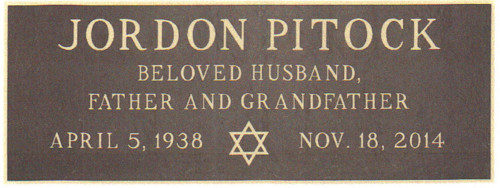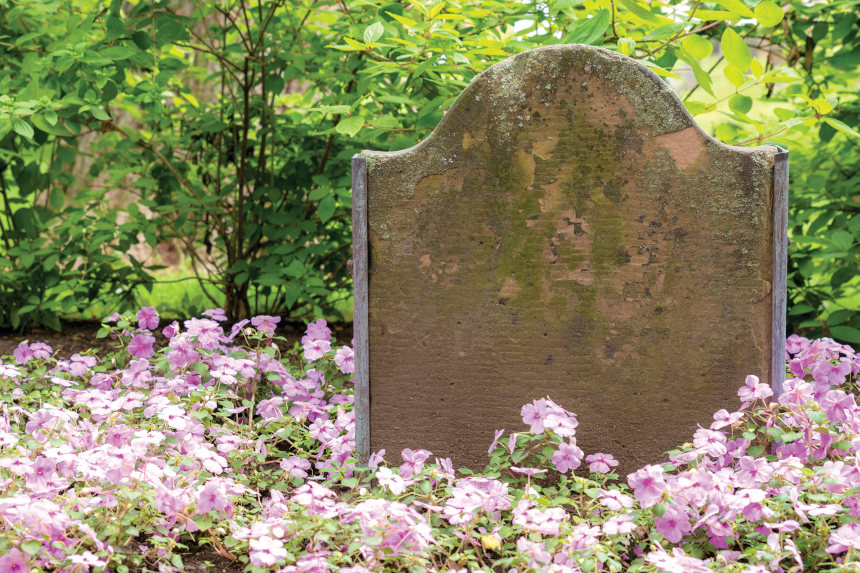Whenever I voiced a complaint, my father would say, “Put it on my epitaph.” In a more serious mood, he would speak about the importance of “leaving your mark.”
But soon before he died after a decade of illnesses, injuries, infections, and all manner of indignities they wrought on him, body and soul, he told his wife he simply wanted to be cremated; she intended to scatter his ashes by a tree on their property that he liked to gaze upon.
That didn’t seem right. Although neither burial nor stones are universal, a marker says “I was here” in a way that addresses a need, both for the one who is leaving and the ones left behind.
I called the cemetery where his parents and older brother were buried. Bruce Jaffe, the cemetery salesman, suggested affixing a bronze plaque to my uncle’s headstone. I liked that idea. My father had admired his brother. Bruce asked what I wanted it to say. A plaque has space for four lines, about 25 characters per line depending on the font. A full headstone typically has space for seven lines — like some prehistoric form of Twitter.
I realized then that I hadn’t given it any thought. I was even a bit embarrassed, as if I’d shown up for an important test completely unprepared.
“Usually people put the person’s name, the years they lived, and their relationships,” said Bruce.
“Okay,” I said. “Let’s do that.”

But when I got the proofs of what the marker would look like, I had second thoughts. I’d wanted to rescue my father from oblivion and fix a place in the world for him, and I felt as if this wasn’t quite doing the job.
Epitaphs, even spare ones, can tell us a lot and elicit all kinds of responses. My rabbi, Jacob Rosner, once observed that the real meaning in an epitaph isn’t the years of birth and death, but the space between them, sometimes noted in a dash, sometimes just blank. Those are the years when a person made choices that shaped their life.
Epitaphs have always fascinated me. In a sense, they narrate a cemetery. A few months earlier during a visit to southern Myanmar, what used to be called Lower Burma, I visited the War Cemetery in Thanbyuzayat. Between 1942 and 1943, 13,000 Allied soldiers died here, prisoners of war whom the Japanese enslaved to build the 258-mile Burma-Siam Railway line. The prisoners died of starvation, cholera, dengue fever, and malaria. They died of exposure to extreme heat. Some were killed when Allied forces bombed the railway line.
Here, the epitaphs of more than 3,000 of them, set in lozenges in the ground, were more than markers. They were messages from parents, siblings, and wives, terrible cries from broken hearts. To an H.H. Shand: “Always in my thoughts and for ever in my heart. Your loving wife Pat.” T. Nolan died on September 29, 1943: “Sadly missed by Dad and Mam, Brothers and Sisters, RIP.” And J.R. Wootton, age 24, August 1942: “In precious memory of my beloved only child, a dear son and a brave lad, Mother.”
The messages were from the living to their dead, but now all the survivors were surely gone, too, and the epitaphs preserved their terrible losses and gave them all a voice, almost in a ghostly way in this most concise literary form, from the grave.
Not every culture has epitaphs. Up in the Arctic Circle of western Greenland, the world’s largest island after Australia, with just 57,000 people, new graves in the cemeteries are decorated with ebullient arrangements of artificial flowers, which, when they wither from the elements, are not replaced. “We do not visit graves,” said Salik Hard, a Greenlander I met while traveling there. “Once a person is gone, we go on to the future.”
And because of that, Greenlanders don’t use epitaphs, not even names.
They are officially Evangelical Lutherans but retain many of the beliefs of their Inuit heritage, including that every person consists of a body, a spirit, and a name. When the body perishes, the spirit and the name travel together in search of a new body.
“If you put a name on the stone,” Salik explained, “it will never leave the grave. It will be trapped. Obviously.”
In my dissatisfaction with how I’d handled my father’s epitaph, I reached out to my friend Milos Curik, who lives in Prague and specializes in funeral arts. “I’m afraid there is no ‘proper way,’” he wrote back. “A person may prepare his own but it’s quite rare (usually celebrities, exhibitionists, people with a special sense of humor). I myself created an epitaph for my old friend who was 95 when he ‘joined the majority.’ He was my professional colleague … studying cemeteries a long time before me. On his tombstone it says: Expert on Funeral Art. My intuition told me such an inscription would be fully justified, funny, and that he would appreciate it.”
I’d wanted to rescue my father from oblivion and fix a place in the world for him.
The epitaph is of course for the living. Yet, we tend to ask ourselves, what would the dead want? How much does it depend on where they are at a particular moment in their lives when you ask? At the time he died my father was completely defeated. All he wanted, he said, was peace and quiet. Oblivion in all forms appeared to him as a state of complete repose. But the conclusion of his life was not the sum of it.
My father was a husband twice, a father three times, plus two stepchildren he was close to, and a grandfather 10 times. He relished that, at least the idea of it. But what he really loved was being a street fighter of a lawyer, watching television, playing golf, and enjoying long afternoons of cards with his friends. And food. Grandparenthood was his period of superannuation, and he fell into deep holes of depression mourning his health and vitality. So why write that he was a grandfather when what mattered was being a lawyer? But honestly: “Jordon Pitock, Attorney-at-Law, Club Champion”? “Jordon Pitock, Good Eater”?
It brought to mind the Greenlanders’ view of tombstones. Not so much that by putting my father’s name on his brother’s stone a piece of him would be literally trapped and bound to the earth, but that the words written on his epitaph would be too narrow and trap his identity. Perhaps, I realized, the Greenlanders are right, and death, including what we fix in plaques and stones, really should just be the great and final liberation, and that when we cross the frontier beyond words, we should get to take them all with us and leave none behind at all.
In truth, my father didn’t like to be bothered over details. He’d say: “Do whatever makes you happy,” which was simultaneously sincere and indifferent, and was generally the source of his own pleasures and problems.
At the unveiling to acknowledge the marker, it still gnawed at me that I hadn’t done more, and I couldn’t help but notice others who had. And that just as some people have become active participants in planning other end-of-life matters, so too are they crafting their final words. One in particular got my attention, a headstone shared by Bess and Marty Katz noted their attributes. Bess: feminist, listener, mentor, organiser. Marty: generous, artistic, calm, cultured. This was tender and touching. Marty, who lived to be 95, outlived Bess by 11 months, and I can easily imagine her loss was what finally did him in.
But I could easily picture how my father would have reacted: He would have laughed out loud and wondered what they were thinking. And I think I know, too, what he would have advised me. “What are you making a federal case out of it for?” he’d say. “What difference? What do I care? I’m dead.”
But even if a marker really didn’t matter to my father, I know it would have mattered to him that it mattered to me, and that he would have understood my effort to create a signpost of his life — however inadequate it was — as a final act of love.
Todd Pitock’s last piece for the Post was “My Life as a Meme” in the July/August 2019 issue.
This article is featured in the September/October 2019 issue of The Saturday Evening Post. Subscribe to the magazine for more art, inspiring stories, fiction, humor, and features from our archives.
Featured image: Shutterstock.
Become a Saturday Evening Post member and enjoy unlimited access. Subscribe now



